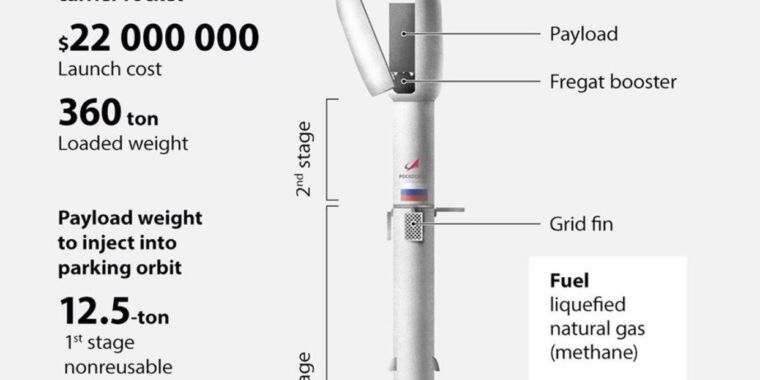
-
Here's a schematic of the proposed Amur rocket.GK Launch Services
-
How the Amur rocket would land.GK Launch Services
-
A Falcon 9 rocket on the launch pad.
-
A Falcon 9 rocket with landing legs deployed.
On Wednesday Russia's state space corporation, Roscosmos, unveiled plans to develop a new "Amur" rocket.
The booster will be powered by new and as yet undeveloped rocket engines that burn methane. Just as significantly, for the first time, Russia is seeking to build a reusable first stage. And Roscosmos is targeting a low price of just $22 million for a launch on Amur, which is advertised as being capable of delivering 10.5 tons to low-Earth orbit.
"We would like our rocket to be reliable, like a Kalashnikov assault rifle," said Alexander Bloshenko, executive director of Roscosmos for Advanced Programs and Science.
What is perhaps most striking about the Amur rocket design, however, is how much it resembles a smaller version of SpaceX's Falcon 9 rocket, which can lift about twice as much payload into orbit.
The resemblance begins at the top, with a wider fairing than the core of the rocket. SpaceX's Falcon 9 rocket has a payload fairing with a 5.2-meter diameter, and the proposed Amur design has a 4.1-meter diameter. Both rockets feature a set of grid fins at the top of the first stage and landing legs at the base. Instead of using nine engines, like the Falcon 9, the Amur booster will use five RD-169 engines.
Whereas the Falcon 9 rocket's first stage is designed to either return to its launch site or land downrange on a drone ship, the Amur booster will launch from the Vostochny Cosmodrome in eastern Russia and land downrange, possibly at a site to be constructed along the Sea of Okhotsk. For now, Russia is not planning to land the booster at sea, due to often rough conditions in the Sea of Okhotsk.
Roscosmos said development costs of the booster will not exceed $900 million, and each Amur first stage will be designed to fly 10 missions during the initial test phase. If this sounds familiar, in terms of commonality, SpaceX's goal is to fly a Falcon 9 first stage for the tenth time in 2021.
This all sounds good, especially the competitive price point of $22 million, which is low for a medium-lift booster if Roscosmos and its contractors can deliver. It is important to note that Russia's space leader, Dmitry Rogozin, has announced a number of ambitious space projects in recent years and then taken no actions to see that they're carried through.
Moreover, even under Roscosmos' most optimistic timeframe, Amur would not be ready to fly until 2026. This is a long time for a rocket development program, and it's difficult to say what kind of market the booster will be entering into. For example, if SpaceX is able to make good on its plans to build a fully reusable Starship launch system, that vehicle could be able to launch 10 times as much as Amur for a similar cost, or less. This would seemingly make it difficult for the Amur booster to increase Russia's share of the commercial satellite launch market.
Commenting on the Amur rocket on Twitter, SpaceX founder Elon Musk said, "It’s a step in the right direction, but they should really aim for full reusability by 2026. Larger rocket would also make sense for literal economies of scale. Goal should be to minimize cost per useful ton to orbit or it will at best serve a niche market."
Listing image by GK Launch Services
The Link LonkOctober 07, 2020 at 12:40AM
https://ift.tt/30FrIrV
Russian space corporation unveils planned “Amur” rocket—and it looks familiar - Ars Technica
https://ift.tt/2DVP6sH

No comments:
Post a Comment